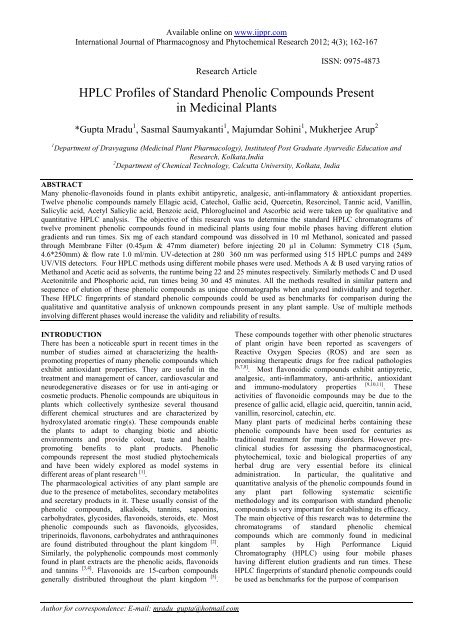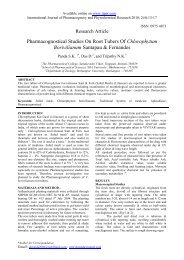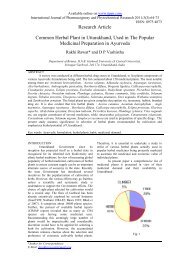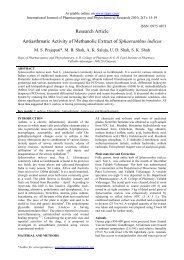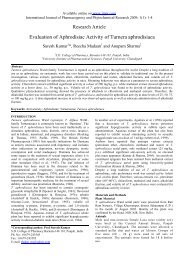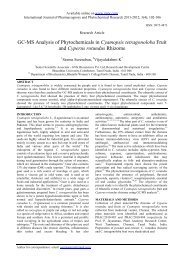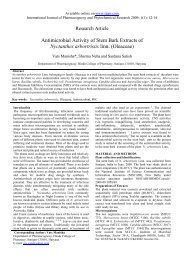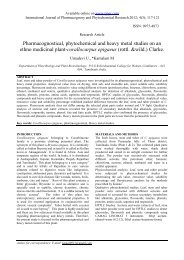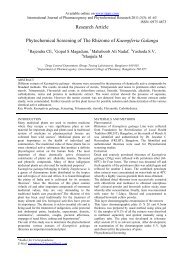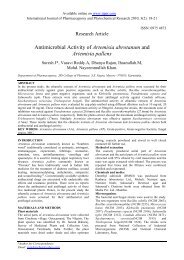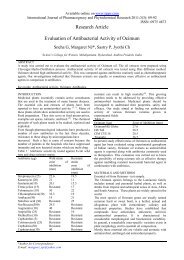HPLC Profiles of Standard Phenolic Compounds Present in ...
HPLC Profiles of Standard Phenolic Compounds Present in ...
HPLC Profiles of Standard Phenolic Compounds Present in ...
You also want an ePaper? Increase the reach of your titles
YUMPU automatically turns print PDFs into web optimized ePapers that Google loves.
Gupta. Mradu et.al./ Hplc <strong>Pr<strong>of</strong>iles</strong> <strong>of</strong> <strong>Standard</strong>…water) [14] . The gradient program was begun with 85 % Band was held at this concentration for the first 12 m<strong>in</strong>utes.This was followed by 75 % eluent B for the next 10m<strong>in</strong>utes after which its concentration was aga<strong>in</strong> <strong>in</strong>creasedto 85 % for the next 8 m<strong>in</strong>utes.Method D1.Total run time was 45 m<strong>in</strong>utes2.Gradient elution <strong>of</strong> two solvents was used- Solvent A(Acetonitrile) and Solvent B (0.1% Phosphoric acid <strong>in</strong>water) [15] . The gradient program was started with 8 % <strong>of</strong>A for the first 35 m<strong>in</strong>utes and then <strong>in</strong>creased to 22 % forthe next 10 m<strong>in</strong>utes before br<strong>in</strong>g<strong>in</strong>g it down aga<strong>in</strong> to 8 %.RESULTS AND DISCUSSIONMethod A: Chromatograms <strong>of</strong> ten out <strong>of</strong> twelve standardphenolic compounds namely Ellagic acid (8.9 m<strong>in</strong>),Catechol (7.912 m<strong>in</strong>), Gallic acid (6.85m<strong>in</strong>), Quercet<strong>in</strong>(10.34 m<strong>in</strong>), Resorc<strong>in</strong>ol (7.64 m<strong>in</strong>), Tannic acid (4.10m<strong>in</strong>), Vanill<strong>in</strong> (8.80 m<strong>in</strong>), Salicylic acid (10.92 m<strong>in</strong>),Acetyle Salicylic Acid (9.90 m<strong>in</strong>) and Benzoic acid (9.90m<strong>in</strong>) which were clearly eluted at different retentiontimes could be obta<strong>in</strong>ed us<strong>in</strong>g the mobile gradient phaseconsist<strong>in</strong>g <strong>of</strong> methanol and acetic acid <strong>in</strong> water (1:25) for22 m<strong>in</strong>utes run time when each <strong>of</strong> these compounds wereanalyzed <strong>in</strong>dividually. Phlorogluc<strong>in</strong>ol and Ascorbic acidwere not separated follow<strong>in</strong>g the same method. The<strong>HPLC</strong> pr<strong>of</strong>ile <strong>of</strong> all these 12 phenolic compounds whentaken together showed the same sequence <strong>of</strong> elution us<strong>in</strong>gthis method, with the comb<strong>in</strong>ed Chromatogram giv<strong>in</strong>g theappearance <strong>of</strong> be<strong>in</strong>g a collage <strong>of</strong> the n<strong>in</strong>e <strong>in</strong>dividualchromatography pr<strong>of</strong>iles, the elution times <strong>of</strong> <strong>in</strong>dividualpeaks be<strong>in</strong>g quite close to the above-mentioned times(Figure 1 and Table 1).Method B : <strong>HPLC</strong> pr<strong>of</strong>iles <strong>of</strong> eleven out <strong>of</strong> twelvestandard phenolic compounds namely Ellagic acid(4.40m<strong>in</strong>), Catechol (3.60 m<strong>in</strong>), Gallic acid (2.67m<strong>in</strong>),Quercet<strong>in</strong> (18.76 m<strong>in</strong>), Resorc<strong>in</strong>ol (3.10 m<strong>in</strong>), Tannicacid (2.47m<strong>in</strong>), Vanill<strong>in</strong> (3.84 m<strong>in</strong>), Salicylic acid (19.51m<strong>in</strong>), Acetyle Salicylic Acid (4.73 m<strong>in</strong>), Benzoic acid(6.75 m<strong>in</strong>) and Phlorogluc<strong>in</strong>ol (2.60 m<strong>in</strong>) hav<strong>in</strong>g differentelution times could be obta<strong>in</strong>ed when each compoundwas analyzed <strong>in</strong>dividually us<strong>in</strong>g the mobile gradientphase consist<strong>in</strong>g <strong>of</strong> methanol and 1% acetic acid <strong>in</strong> waterdur<strong>in</strong>g 25 m<strong>in</strong>utes run time. However, Ascorbic acid wasnot separated dur<strong>in</strong>g this method. The Chromatographicf<strong>in</strong>ger pr<strong>in</strong>t <strong>of</strong> these 12 phenolic compounds when mixedtogether exhibited the same elution sequence; thecomb<strong>in</strong>ed Chromatogram resembl<strong>in</strong>g a synchronizedcollation <strong>of</strong> the <strong>in</strong>dividual <strong>HPLC</strong> pr<strong>of</strong>iles, the <strong>in</strong>dividualpeak times be<strong>in</strong>g quite similar to the above-mentionedtimes (Figure 2 and Table 2).Method C: Chromatograms <strong>of</strong> eight phenolic compounds,i.e., Ellagic acid (11.86 m<strong>in</strong>), Catechol (9.08 m<strong>in</strong>), Gallicacid (3.50 m<strong>in</strong>), Resorc<strong>in</strong>ol (7.15 m<strong>in</strong>), Vanill<strong>in</strong> (12.77m<strong>in</strong>), Acetyle Salicylic Acid (17.46 m<strong>in</strong>), Benzoic acid(19.19 m<strong>in</strong>) and Ascorbic acid (2.56 m<strong>in</strong>) hav<strong>in</strong>gretention times mentioned above could be obta<strong>in</strong>ed us<strong>in</strong>gmobile gradient phase <strong>of</strong> Acetonitrile and 0.1%Phosphoric acid <strong>in</strong> water at 30 m<strong>in</strong>utes run time wheneach chemical was <strong>in</strong>dividually analyzed. Quercet<strong>in</strong>,Tannic acid, Salicylic acid and Phlorogluc<strong>in</strong>ol were notseparated <strong>in</strong> this method. The <strong>HPLC</strong> f<strong>in</strong>ger pr<strong>in</strong>ts <strong>of</strong> amixture consist<strong>in</strong>g <strong>of</strong> these 12 phenolic compoundsrevealed the same pattern <strong>of</strong> elution us<strong>in</strong>g this method,with the comb<strong>in</strong>ed Chromatogram appear<strong>in</strong>g like anaggregation <strong>of</strong> <strong>in</strong>dividual pr<strong>of</strong>iles (Figure 3 and Table 3).Method D: Us<strong>in</strong>g this method <strong>in</strong>volv<strong>in</strong>g a mobile gradientphase consist<strong>in</strong>g <strong>of</strong> Acetonitrile and 0.1% Phosphoricacid <strong>in</strong> water for 45 m<strong>in</strong>utes run time, the <strong>HPLC</strong> analysis<strong>of</strong> 9 phenolic compounds, namely Ellagic acid (31.88m<strong>in</strong>), Catechol (15.60 m<strong>in</strong>), Gallic acid (5.38 m<strong>in</strong>),Resorc<strong>in</strong>ol (12.35 m<strong>in</strong>), Tannic acid (32.74 m<strong>in</strong>), Vanill<strong>in</strong>(28.99 m<strong>in</strong>), Acetyle Salicylic Acid (39.18 m<strong>in</strong>), Benzoicacid (40.50 m<strong>in</strong>) and Ascorbic acid(2.79) could be donewhile Quercet<strong>in</strong>, Salicylic acid and Phlorogluc<strong>in</strong>ol werenot separated. The <strong>HPLC</strong> pr<strong>of</strong>ile <strong>of</strong> these 12 phenoliccompounds when comb<strong>in</strong>ed together exhibited the samesequence <strong>of</strong> elution, with the comb<strong>in</strong>ed Chromatogram <strong>of</strong>n<strong>in</strong>e phenolic compounds giv<strong>in</strong>g the appearance <strong>of</strong> be<strong>in</strong>ga superimposition <strong>of</strong> <strong>in</strong>dividual chromatography pr<strong>of</strong>ileswith similar peak elution times (Figure 4 and Table 4).DISCUSSIONThe <strong>HPLC</strong> f<strong>in</strong>gerpr<strong>in</strong>ts <strong>of</strong> these standard phenoliccompounds obta<strong>in</strong>ed us<strong>in</strong>g the methods described abovewould serve the purpose <strong>of</strong> established benchmarks forfuture plant research. The qualitative and quantitativeanalysis <strong>of</strong> the actual phenolic compounds present <strong>in</strong> anyunknown plant sample would be facilitated by means <strong>of</strong>comparison with such standard chromatograms, enabl<strong>in</strong>gidentification & confirmation <strong>of</strong> presence <strong>of</strong> any <strong>of</strong> these12 common phenolic compounds <strong>in</strong> the research sample.The use <strong>of</strong> multiple methods <strong>in</strong>volv<strong>in</strong>g different mobilegradient phases would <strong>in</strong>crease the validity and reliability<strong>of</strong> the obta<strong>in</strong>ed results.ACKNOWLEDGEMENTSThe study was supported by the Directorate <strong>of</strong> Ayurvedaunder the Health & Family Welfare department,Government <strong>of</strong> West Bengal by provid<strong>in</strong>g thesophisticated <strong>HPLC</strong> <strong>in</strong>strument. A part <strong>of</strong> the researchwas also funded by the University Grants Commissionand the Department <strong>of</strong> Science & Technology,Government <strong>of</strong> West Bengal by way <strong>of</strong> provision <strong>of</strong> thestandard phenolic compounds for research <strong>in</strong> thelaboratory <strong>of</strong> department <strong>of</strong> Dravyaguna Vigyan(Medic<strong>in</strong>al plant Pharmacology) <strong>of</strong> I.P.G.A.E.R. Kolkata.REFERENCES1. Boudet Ala<strong>in</strong>-Michel. Evolution and current status <strong>of</strong>research <strong>in</strong> phenolic compounds. Phytochemistry2007; 68 (22-24): 2722-2735.2. Harborne J B. Phytochemical Methods, A Guide tomodern Techniques <strong>of</strong> Plant Analysis. Chapman andHall, London, 1973, 33-41.3. Naik G H, Priyadars<strong>in</strong>i K I, Hari M. Free radicalscaveng<strong>in</strong>g reactions and phytochemical analysis <strong>of</strong>Triphala, an ayurvedic formulation. Curr. sci. 2006;90: 1100-1105.Page166IJPPR, Vol- 4, Issue 3, September-November 2012, 162-167
Gupta. Mradu et.al./ Hplc <strong>Pr<strong>of</strong>iles</strong> <strong>of</strong> <strong>Standard</strong>…4. Sati S C, Sati N, Rawat U, Sati O P. Medic<strong>in</strong>al plantsas a source <strong>of</strong> antioxidants. Res. J. Phytochem. 2010;4: 213-224.5. Harborne J B. Introduction to EcologicalBiochemistry. 3 rd Edn., Academic Press, London,1988, 356.6. Chang H C, Huang G J, Agrawal D C, Kuo C L, WuC R, Tsay H S. Antioxidant activities and polyphenolcontents <strong>of</strong> six folk medic<strong>in</strong>al ferns used as Gusuibu.Botanical Stud 2007; 48: 397-406.7. Khasawneh M A, Elwy H M, Fawzi N M, Hamza AA, Chevidenkandy A R, Hassan A H. Antioxidantactivity, lipoxygenase <strong>in</strong>hibitory effect andpolyphenolic compounds from Calotropis procera(Ait.). R. Br. Res. J. Phytochem. 2011; 5: 80-88.8. Boligon A A, De Brum T F, Frolhich J K, Froeder AL F, Athayde M L. <strong>HPLC</strong>/DAD Pr<strong>of</strong>ile andDeterm<strong>in</strong>ation <strong>of</strong> Total <strong>Phenolic</strong>s, Flavonoids,Tann<strong>in</strong>s and Alkaloids Contents <strong>of</strong> Scutia buxifoliaReissek Stem Bark. Research Journal <strong>of</strong>Phytochemistry 2012; 6(3): 84-91.9. Wang M, Li K, Nie Y, Wei Y, Li X.Antirheumatoid Arthritis Activities and ChemicalCompositions <strong>of</strong> <strong>Phenolic</strong> <strong>Compounds</strong>-Rich Fractionfrom Urtica atrichocaulis, an Endemic Plant toCh<strong>in</strong>a. Evidence-Based Complementary andAlternative Medic<strong>in</strong>e 2012.doi:10.1155/2012/818230.10. Balasundram N, Sundram K, Samman S. Analytical,Nutritional and Cl<strong>in</strong>ical <strong>Phenolic</strong> compounds <strong>in</strong>plants and agri-<strong>in</strong>dustrial by-products: Antioxidantactivity, occurrence, and potential uses. FoodChemistry 2006; 99(1): 191–203.11. Gill N S, Arora R, Kumar S R. Evaluation <strong>of</strong>antioxidant, anti-<strong>in</strong>flammatory and analgesicpotential <strong>of</strong> the Luffa acutangula Roxb. Var. amara.Res. J. Phytochem. 2011; 5: 201-208.12. Giri L, Andola H C, Purohit V K, Rawat M S M,Rawal R S, Bhatt I D. Chromatographic and spectralf<strong>in</strong>gerpr<strong>in</strong>t<strong>in</strong>g standardization <strong>of</strong> traditionalmedic<strong>in</strong>es: An overview as modern tools. Res. J.Phytochem. 2010; 4: 234-241.13. L<strong>in</strong> Y L, Chen Y L, Liang Y C, L<strong>in</strong> J K.Composition <strong>of</strong> Polyphenols <strong>in</strong> fresh Tea Leaves andAssociations <strong>of</strong> their Oxygen Radical Absorb<strong>in</strong>gCapacity with Antiproliferative Actions <strong>in</strong> FibroblastCells. J. Agri. Food Chem. 1996; 44:1387-1394.14. Penarrieta J M, Alvarado J A, Akesson B,Bergenstahl B. Separation <strong>of</strong> <strong>Phenolic</strong> <strong>Compounds</strong>from Foods by Reversed-Phase High PerformanceLiquid Chromatography, Revista Boliviana DeQuimica 2007; 24(1): 1- 4.15. Samee W, Vorarat S. Simultaneous Determ<strong>in</strong>ation <strong>of</strong>Gallic acid, Catech<strong>in</strong>, rut<strong>in</strong>, Ellagic acid andQuercet<strong>in</strong> <strong>in</strong> Flower Extracts <strong>of</strong> Michelia alba,Caesalp<strong>in</strong>ia pulcherrima and Nelumbo nucifera by<strong>HPLC</strong>. The Pharm Health Sci J. 2007; 2(2): 131-137.Page167IJPPR, Vol- 4, Issue 3, September-November 2012, 162-167


